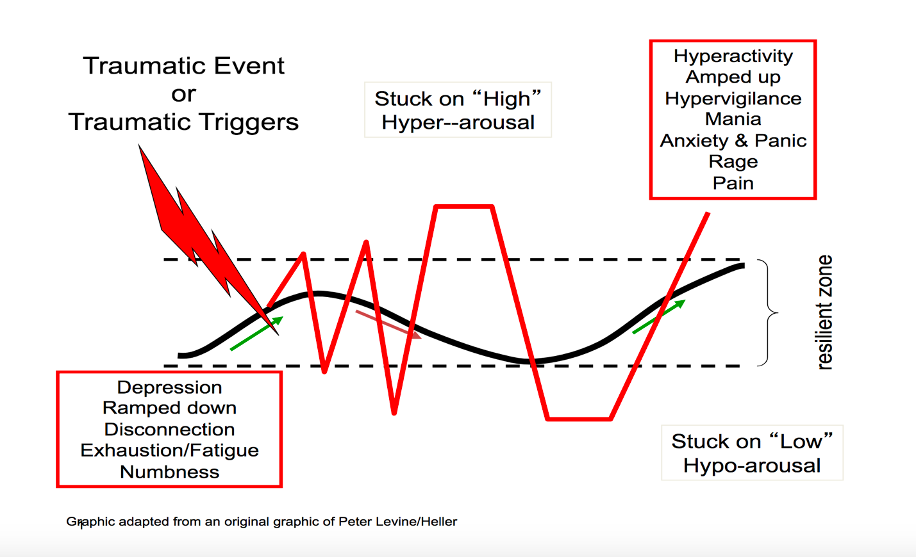Trauma-Informed Practices
As Moser (2012) writes, “One clear demand…on you as an [environmental] leader is to be at ease with your own grief, so as to provide a strong container for that of others… leaders must grow their capacity to be with people in crisis, in deep uncertainty, distress, worry, anxiety, fear, denial, and grief. And they must resist their own, and help others avoid, the knee-jerk response of ideological hardening, defensiveness, and blame” (pp. 8-9).
To do this, we can look to a range of resources and disciplines within the field of psychology, mindfulness and trauma-informed practices. While it is outside the scope of this course to dive deeply into the full range of fields of study, selected readings are included in the Optional Readings list for this module. These resources can provide a strong foundation both for your own self-care as climate adaptation practitioners and for the development of psychologically supportive dialogue and engagement practices.
One of these is the area of trauma-informed practice and, in particular, the concept of the Window of Tolerance as developed by Dr. Daniel Siegel (2012), or a similar concept, developed by Peter Levine (2013), called the Zone of Resilience. In both models, the window or zone describes the state in which our nervous system is regulated enough for us to be attentive, focused and able to respond from an optimal place of wellbeing – a place that accesses our creativity, insight and executive function. The image below offers an example of this dynamic.
(Source: Pacific Aids Network. (2013). Community Resiliency Model Workbook. https://pacificaidsnetwork.org/files/2013/12/Community-Resiliency-Model-Workbook-Sept.-2013.doc1_.pdf )
There are many stressors that might push us outside of our window of tolerance into fight, flight, or freeze responses, also described as either hyper-arousal or hypo-arousal. In all cases, these kinds of responses to threats and stressors can serve a life-saving or adaptive function. A rapid response to flee, to fight, or to disengage can be just the right protective response to some circumstances. However, our nervous systems are not designed to sustain these reactions over long periods of time. In optimal circumstances, the threat resolves, and our nervous system is able to (quite literally in some cases) shake off or process the feelings in order to return to a more regulated state.
When we don’t have the opportunity to move or process these experiences, or the threats are not resolved, there is greater likelihood that we become stuck outside our window in either hypo-arousal (which can look like depression, numbness, exhaustion, and disengagement) or hyper-arousal (which can include anxiety, extreme anger, manic activity and hypervigilance). As the realities of the climate crisis become more and more present, along with other significant stressors such as a global pandemic, we are, as Lertzman points out, “Collectively being pushed outside our window of tolerance,” (Lertzman, 2019) with no indication that these stressors are likely to dissipate. It’s also important to recognize that the psychological impact of climate change is likely to be compounded by historical and persistent stressors due to the systemic intersections of racism, poverty, colonialism, transphobia, homophobia, ableism and more.
At the same time, climate adaption work often requires us to invoke additional stress through climate projections and modeling, as well as conversations about trade-offs and scenario planning. We might ask ourselves, then, what methods and approaches can be incorporated into engagement and dialogue practice that support us and those we work with to return to a state of greater self-regulation or back towards a window of tolerance?
Fortunately, a trauma-informed lens, as well as insights from the literature on grief and grieving, provide some pathways forward. The trauma-informed lens describes three aspects of human experience and need that are critical to support if we hope to avoid defensive responses and engage effectively. These are: Safety; connection; and authentic action (Crawford & Dempsey, 2020). It is important to recognize that these needs are interdependent and non-linear and are sequenced according to the roles they play in our nervous system and neurological functioning. For example, the need for safety lives in our brain stem and needs to be cared for in order for someone to engage fully with group connection and, subsequently, with the part of the brain responsible for executive function that might generate new and creative ideas or participate in deliberation and problem solving with others.
In application, attending to these needs can look like empathizing with our audience or partners who might be asking themselves questions such as: Is my well being and the well being of those I care about under threat and am I going to be taken care of?; Am I part of a larger group of people with whom I feel connected and safe?; Can I play a meaningful role in the work to address the threat and the issues I care about?
It’s important to note that none of these approaches focus on creating optimism or hopefulness for their own sake. While these attitudes may arise among some participants involved in a psychologically supportive or trauma-informed climate adaptation process, these states of being are not required for meaningful engagement (Moser, 2012).
In the rest of this module, we review specific activities and tactics that can be implemented to attune our work around these core needs for safety, connection and authentic action.


